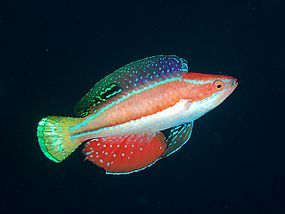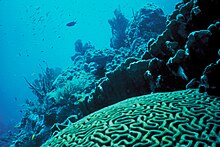User:Halfback2303/sandbox
Cirrhilabrus Shutmani, popularly known as the magma wrasse, was discovered by RVS Fishworld in 2016 living around the Didicas Volcano in the Caguyan Island. The magma wrasse belongs to the family of 'Labridae', a colourful species of tropical and subtropical fish. The magma wrasse is found in tropical coral reef, within the depth range of 50-70m . This species of fish usually inhabits steep slopes around coral reefs made up of loose rubble,[1] however can be be purchased within the aquariums trade.
Family[edit]
| Cirrhilabrus | |
|---|---|

| |
| Cirrhilabrus katoi | |
| Scientific classification | |
| Kingdom: | |
| Phylum: | |
| Class: | |
| Order: | |
| Family: | |
| Genus: | Cirrhilabrus |
| Type species | |
| Cirrhilabrus temminckii Bleeker, 1853
| |
| Synonyms | |
|
Cheilinoides Bleeker, 1851 | |
The Labridae family are the second most diverse fish family, with more than 80 genera and 500 species. A large family of mostly long, slender colourful fishes with a single long-based dorsal fin, well developed pectoral fins used for swimming, thick lips, jaws with well-developed canine teeth and cycloid scales. Most of the Labridae family are found in Australian waters.[2]
There are 9 subgroups of Labridae:
| Cheilines |
|---|
| Julidines |
| Labrines |
| Pseudocheilines |
| Scarines |
| Hypsigenyines |
| Labrichthyines |
| Novaculines |
| Pseudolabrines |

Higher Classification: Genus Cirrhilabrus[edit]
Specifically, the magma wrasse belongs to the Cirrhilabrus genus. A genus of very small, very colourful wrasses usually found over rubble bottoms on coral reefs in the Indo-Pacific mostly below 20-30m. Males and females are usually sexually dichromatic and live in small harems comprising a dominant male and a small group of females[3]. The magma wrasse is part of a new wave of recently described fairy wrasses species and brings the total number of species in this group up to 56.[4]

Family Tree[edit]
Cirrhilabrus (Genus) > shutmani (Species)[5]
Discovery[edit]
Cirrhilabrus shutmani was a new species discovered in August 2016. The species was affirmed on the basis of four specimens from Didicas Volcano, Babuyan Islands, Cagayan province, northern Philippines. The holotype and three paratypes were collected at a depth of 50-70 meters, along denude rubble slope. Comparatively, Cirrhilabrus shutmani appeared to be closely related to C. Blatteus, C. Claire, C. Earlei, C. Jordani, C. Lanceolatus, C. Roseafascia, C. Rubrisquamis, C. Sanguineus upon discovery.[6]
Habitat and Behaviour[edit]
The magma wrasse, like most Labrids, occupy areas that include turtlegrass beds, sandy patch reefs, plain sand bottom, coral reefs, and rocky flats[7]. Eating a carnivorous diet consumed mostly of gastropods and bivalves, the magma wrasse utilises its pharyngeal jaws formed by ceratobranchial and pharyngobranchial bones, to crush the shells of its prey.

Anatomy[edit]
Cirrhilabrus shutmani shares similar meristic counts to the other species in its complex, but differs from congeners in the following details: upper part of nape dusky red; dorsal and anal fin bright red dusky markings; pelvic fins bright red, dusky, and unmarked; caudal fin bright yellow basally with distal half bright red.[8]
Aquarium[edit]
The magma wrasse is an available fish for home and public aquariums. To successfully maintain its health, this wrasse requires a carnivorous diet rich in meaty food, such as brine and mysis shrimp, high quality frozen foods, pieces of fresh seafood, and flake and pellet foods. They need to be fed two of three times a day to stay healthy.[9]

References[edit]
- ^ "Cirrhilabrus shutmani summary page". FishBase. Retrieved 2019-05-14.
- ^ "LABRIDAE". fishesofaustralia.net.au. Retrieved 2019-05-14.
- ^ "Cirrhilabrus". fishesofaustralia.net.au. Retrieved 2019-05-14.
- ^ "The Magma Fairy Wrasse, Cirrhilabrus shutmani, Just Described From Northern Philippines". Reef Builders | The Reef and Marine Aquarium Blog. 2017-11-01. Retrieved 2019-05-14.
- ^ "Cirrhilabrus". fishesofaustralia.net.au. Retrieved 2019-05-14.
- ^ Tea, Yi-Kai; Gill, Anthony C. (2017). "Cirrhilabrus shutmani, a new species of fairy wrasse from the Babuyan Islands, northern Philippines (Teleostei: Labridae)". Zootaxa. 4341 (1): 77–88. doi:10.11646/zootaxa.4341.1.6. ISSN 1175-5334. PMID 29245702.
- ^ "Labridae, the Wrasses". ResearchGate. Retrieved 2019-05-15.
- ^ Tea, Yi-Kai; Gill, Anthony C. (2017). "Cirrhilabrus shutmani, a new species of fairy wrasse from the Babuyan Islands, northern Philippines (Teleostei: Labridae)". Zootaxa. 4341 (1): 77–88. doi:10.11646/zootaxa.4341.1.6. ISSN 1175-5334. PMID 29245702.
- ^ "Saltwater Fish for Marine Aquariums - Magma Fairy Wrasse (Cirrhilabrus shutmani)". Fishy Business Aquatics. Retrieved 2019-05-14.

